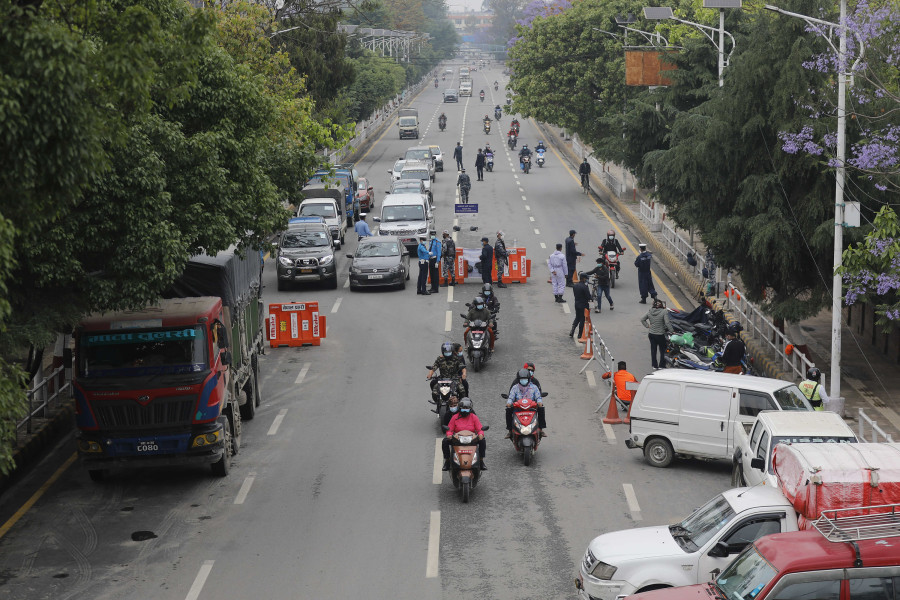National
Curbs need gradual lifting, with other measures to control pandemic, experts say
Contact tracing, testing and isolating are the key and for this whole government machinery must be deployed. But Health Ministry alone cannot do everything, officials say.
Arjun Poudel
By the time the prohibitory orders currently in place in Kathmandu Valley end on June 14, the Capital will have been under lockdown for 47 days. Valley authorities on Wednesday extended the lockdown by 10 more days.
Not only the Valley but much of the country has been under lockdown. Rupandehi, Kaski and Kailali, three of the hardest hit districts, too have extended prohibitory orders till June 14. In Saptari prohibitory orders have been in place indefinitely since May 5.
But restrictions cannot go on indefinitely, experts say.
“It will be unjust to say that restrictions should be continued for an indefinite period, as thousands of people have been severely affected by it,” Dr GD Thakur, former director at the Epidemiology and Disease Control Division, told the Post.
Lockdown needs to be lifted gradually but before that authorities should ensure that risk of explosion of new cases has minimised, according to experts.
For that certain things need to be done—massive testing, contact-tracing, isolating the suspected and infected people, and zoning— identifying areas into red, yellow and green zones—and putting restrictions accordingly, among other measures.
“It has become too difficult for people to survive due to the ongoing restrictions,” Dr Biraj Karmacharya, an epidemiologist, who is also the chief of the Department of Community Programme, at Dhulikhel Hospital, told the Post. “But at the same time we should not forget that the pandemic is not yet over. New cases could surge again and a small wave of infections could be created if restrictions were to be lifted without meeting other necessary measures.”
However, authorities still do not seem to be doing the basics.
“We have been repeating the same thing—increase testing, make contact-tracing effective, isolate the suspected and the infected people,” Dr Mingmar Gyelgen Sherpa, former director general of the Department of Health Services, told the Post. “Before lifting the restrictive measures, authorities should know the status of the infection.”
An official of the Health Ministry conceded that extended lockdowns are not the answer and a lot of things need to be done before relaxing the restrictive measures, which include massive testing and management of crowds.
“But the ministry alone cannot do all this,” said the official on condition of anonymity. “There are other government agencies too and the three tiers of government and they must be equally responsible to check the virus spread.”
After more than four weeks of restrictions in most of the country, the number of those testing positive has gone down. But that is also because the number of tests has gone down.
The number of total infections has come down to 34,680 in the last week between May 28 and June 3, out of the 108,874 polymerase chain reaction tests conducted, from 53,611 in the preceding week between May 21 and May 27, of the 142,271 tests conducted.
The positivity rate came down to 32 percent from 38 in the two weeks. At one point it was as high as 52 percent.
The positivity rate was 31 percent on Thursday while a rate of anything higher than 5 percent is considered to be a situation out of control, according to the World Health Organization.
The Ministry of Health and Population reported 5,825 new infections and 75 deaths on Thursday. The total number of infections now stands at 576,396 of which 101,839 are active. The total death toll stands at 7,630.
There are simply not enough tests being conducted.
Nepal’s 90-odd polymerase chain reaction test laboratories have the capacity of testing a little more than 20,000 samples a day and that capacity has not been increased even while the second wave of the pandemic continues to rage across the country.
Authorities have instead opted for antigen tests with 1.7 million testing kits Nepal received from donors.
Antigen tests have been increasing gradually but positivity rates in these are also dangerously high. On Thursday, of the 3,211 tests, 1,000 were positive, according to the Ministry of Health and Population. (The Post does not include antigen tests in its records.)
The ministry aimed to conduct 25,000 daily antigen tests but blamed the local governments’ reluctance to conduct them for the low numbers.
Meanwhile, Valley authorities may have lifted some restrictions starting Friday like allowing grocery stores to open in the mornings, but experts warn against complacency.
“But at the same time we should not forget that the pandemic is not yet over,” said Karmacharya, of Dhulikhel Hospital.
He points out that last year the number of infections actually increased after the four-month countrywide lockdown was lifted in July and three-week prohibitory orders lifted in early September.
During the first wave the highest number of daily infections was recorded on October 21 with 5,743 new cases.
“We should not forget that the peak of the first wave of infections was reached after lifting all restrictions,” said Karmacharya. “A secondary wave could come after the restrictions are lifted.”
Doctors stressed that authorities concerned should know about the infection status before lifting the restrictions.
But instead science seems to have taken a backseat and the administrators are taking decisions.
According to experts, new infections might have lowered of late but the decision to let the grocery shops open until 9 in the morning and allowing trucks carrying construction materials in the night is not convincing.
“Our main goal of breaking the chain of transmission might not be served if grocery stores are allowed to open for a limited time as people could crowd the stores for daily essentials,” Dr Sher Bahadur Pun, chief of Clinical Research Unit at Sukraraj Tropical and Infectious Disease Hospital, told the Post. “Similarly, viruses spread even at night.”
He said that authorities should instead focus on managing crowds, ensuring social distancing and enforcing safety measures strictly.
Besides these, risk communication remains equally important and this means launching awareness drives for behavioural change following public health measures, doctors say.
“Changing perception and behaviour is not so easy,” Dr Radhika Thapaliya, director at the National Health Education Information and Communication Center under the Department of Health Services, told the Post. “Along with other measures, awareness drives, especially risk communication, play an important role in containing the pandemic in the coming days.”
Thapaliya, who is also an expert on risk communication, said that mechanisms need to be created to know about the people’s problems and their perceptions about the risk and restrictions enforced to contain the spread, and authorities should make strategies accordingly.
“If we could increase testing in sufficient numbers and identify the clusters of infection, restrictions can be loosened up in areas that are not risky,” said Thapaliya. “But it should be ensured that people follow the safety measures including wearing of face masks and maintaining social distance.”
But it is unclear who is making the decisions and who is in charge.
“There is no point in recommending anything,” the Health Ministry official said. “The government did not listen to our recommendations, and does not listen now. We haven’t been recommending anything for the local administrations on the ongoing prohibitory orders.”




 12.12°C Kathmandu
12.12°C Kathmandu



%20(1).jpg&w=200&height=120)









%20(1).jpg&w=300&height=200)

